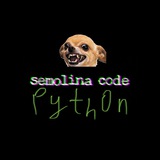tg-me.com/semolina_code_python/11
Last Update:
Просто мозг не привык разбивать задачи на мелкие части и придумывать каждый шаг
Вот для вас всех алгоритм как решать задачи с циклом на примере задачи с равнобедренным треугольником.
1) забейте на цикл и забудьте, что он существует. Решите задачу с помощью принтов:
print(“ *”)
print(“ ***”)
print(“*****”)
Результат:
*
***
*
2) анализируем закономерности в print.
Пробелы: сначала 2, потом 1, потом 0 (на каждом шаге -1)
Звёздочки: сначала 1, потом 3, потом 5 (на каждом шаге + 2)
3) делаем принты одинаковые (с помощью переменной)
spaces = 2
stars = 1
print(“ ” * spaces + stars * “*”)
spaces -= 1
stars += 2
print(“ ” * spaces + stars * “*”)
spaces -= 1
stars += 2
print(“ ” * spaces + stars * “*”)
spaces -= 1
stars += 2
Получаем 3 строчки которые повторяются 3 раза
4) пытаемся понять как это связать с данными, которые ввёл пользователь (в нашем случае высота = h = 3)
spaces в примере изначально была = 2
Это по сути h - 1
stars в любом случае вначале всегда должна равняться 1 (так как это вершина)
5) сколько итераций должен сделать цикл? Столько же сколько и высота:
i = 0
while i < h:
…
i += 1
6) добавим в цикл наш код:
i = 0
while i < h:
print(“ ” * spaces + stars * “*”)
spaces -= 1
stars += 2
i += 1
7) добавим переменные, которые зависят от пользователя:
h = int(input())
spaces = h - 1
start = 1
i = 0
while i < h:
print(“ ” * spaces + stars * “*”)
spaces -= 1
stars += 2
i += 1
8) уже всё работает - пытаемся оптимизировать: можно убрать переменную i и использовать как счётчик переменную spaces (но в условии нужно будет писать spaces >= 0 так как цикл должен закончиться, когда закончатся пробелы)
Получаем неплохой код:
h = int(input())
spaces = h - 1
stars = 1
while spaces >= 0:
print(“ ” * spaces + stars * “*”)
spaces -= 1
stars += 2
SemolinaCode | Chat | YouTube | Arbuzers | HowToCode | Prop
BY Semolina Code (Python / TypeScript)

Share with your friend now:
tg-me.com/semolina_code_python/11
